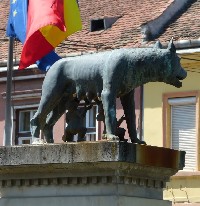Bucharest (București)
Bucharest is a fine old city in decay, like an aging courtesan. For me Bucharest is best represented by its trams. These are great grey thundering monsters that clank heavily and slowly down the streets with no apparent suspension, unlike modern trams elsewhere that glide almost silently along. They are fundamentally shabby yet practical and somehow confident, in a tank-like way, as they force their passage through the unruly traffic.
The hotel we stayed in in Bucharest was once a mansion and has been scrupulously restored to its former glory. It is not an insignificant establishment. But alarmingly the taxi driver bringing us from the airport could not find it on his GPS. When I looked at Google Street View the reason became evident. In July 2014, when the images were captured, the Grand Boutique Hotel was still a construction site, like the similarly grand building on the corner of Strada Negustori that is now undergoing renovation.
Thus Bucharest, with a population of just 1.9 million that feels bigger because of its grand old semi-vacant buildings, is slowly recovering some of its former glory. But it's off a low base - there's a long way to go.
In Ceaușescu's time a large part of the old city was demolished to build a grand boulevard, headed by the vast Parliament building and lined with matching office blocks. The Palace of the Parliament is the second largest administrative building in the world after the Pentagon and the fourth largest building of any kind. We got to see it on our second visit as foreign visitors have to surrender their passport and be accompanied at all times but we had left them in the hotel first time around. We didn't get to visit all eleven hundred rooms nor even either of the two parliamentary chambers but we did see several of the vast halls part of the rooftop and even a cellar. Photographs were prohibited inside.
Ceaușescu's grand boulevard from the Palace of the Parliament balcony
To achieve this he knocked down a good deal of he oldest part of the city which leaves a picturesque remainder that has become a walking shopping/dining precinct. It's adjacent to the university and museums and is quite bohemian with several conspicuous brothels. Local people there, or were some tourists, looked well dressed and prosperous as they promenaded past the Irish Pub or café we happened to be eating or drinking at.
One of several Irish Pubs in the Old City
At the National Museum of Romanian History the principal reference to recent history is the trappings of monarchy, the crown jewels and so on. The Roman occupation also receives a good deal of attention, particularly the time of Trajan whose column is reproduced in plaster. I was a bit bemused as to what it's doing here. It's very lonely as the only exhibit of this genre. The plaster replicas of this column in Rome item occupy most of the building - a collection of one. It's not unique there is similar plaster copy, among thousands of exhibits, in the V&A in London and of course the one in Rome, so I suppose this has been singled out to benefit Romanian scholars of Roman history. A controversial post-modern bronze statue of Trajan stands on the steps outside and passers-by keep his penis bright with frequent fondling.
Trajan on the steps
In addition to trams and trolleybuses, Bucharest also boasts a metro dating from the Ceaușescu era, with four lines and 51 stations. More are planned.
There is a lot to see around Bucharest from Roman ruins to various churches and museums.
Roman ruins; a 'Capitoline Wolf' statue, with Romulus and Remus, beneath her; and two Romanian Orthodox churches
The Wolf is one of five copies of the Roman original given to Romania by Italy in 1921
She represents the new unity of Romanians and their 'Latinity'
We didn't use the public transport but walked to the nearby old-city or used cabs further afield. This was a lesson in itself, as the cab drivers are skilled at exploiting tourists with two quite different fee scales and are best hired by the concierge at one's hotel. As mentioned above we also hired a car and I had the fun of driving in and out of the city.
Using the car we headed to Brașov 270km to the north, enjoying the motorway that extends for a good part of the way.
Near Brașov we saw the first of Transylvania's many fortified Saxon towns and churches. In the twelfth century the Kings of Hungary settled German colonists in the area against the expansion of the Ottomans and Tartars (Turkic Muslims). From the 13th to 16th centuries there around 300 such Christian fortifications were constructed against these 'heathen hordes' that had overrun much of what today is modern Romania. There remain 130, once Saxon, towns and villages in the Transylvania region each with a fortified church.
Obviously the fortified churches were originally Roman Catholic but with the Protestant Reformation they seemingly universally saw the error of their theological ways and adopted Lutheran theology. They remain so today. Their congregations have dwindled over the ages and now a small minority adhere to the Lutheran religion while the great majority of modern Romanians now follow the Eastern (Romanian Orthodox) Rite. Nevertheless the Saxon churches are significant points of interest on the tourist agenda and a number have world heritage listing.
They are also fascinating reminders of the mega-litres of blood that have been shed in the name of conflicting human imaginative conceptions of the divine.

